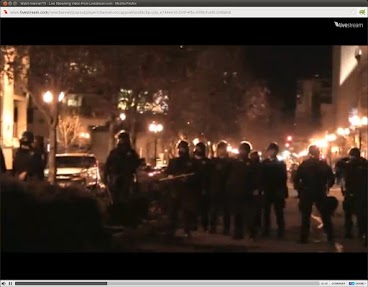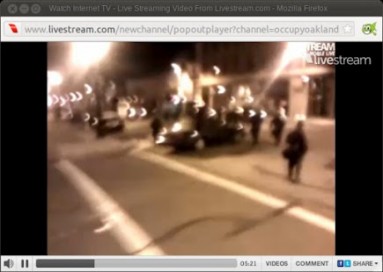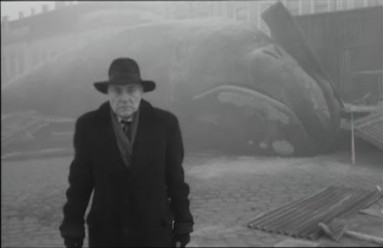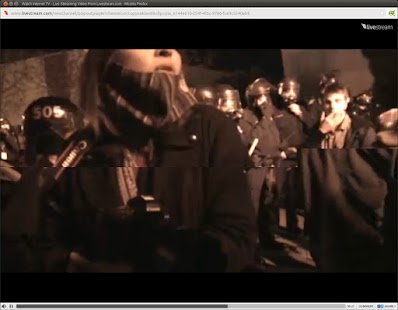And now we’ll have an explanation so that simple folks like us can also understand about immortality. All I ask is that you step with me into the boundlessness, where constancy, quietude, and peace, infinite emptiness reign. And just imagine that in this infinite sonorous silence, everywhere is an impenetrable darkness. Here we only experience general motion, and at first, we don’t notice the events we are witnessing.
- Werckmeister Harmonies
I thought of Bela Tarr’s film, Werckmeister Harmonies, several times as I sat in the Occupied Media Van. I too, was awaiting the approach of what might have been a gigantic whale. I peered through the Livestream window, that conjured square of futuristic omnipresent light and darkness, and I switched tabs to monitor Twitter, its textual equivalent. The “whale” was a line of armed and armored police officers--the militant enforcement edge of the State doing its best to posture a Leviathan of wrath. This was a fantastical creature, a Melvillian metaphor beating inevitably through the wet air on its meaning alone. Leaning forward, I could see it through the spotted windshield of the van, down two blocks, through a throng of people awaiting its inevitable approach. Slowly it moved, on the night streets. Floodlights threw shadows on the crowd. The silhouette of its black corpus loomed forward.
In the film, unlike at the eviction, there was a literal whale. A preserved blue whale, “the largest of the most gigantic animals,” that arrived in a small town to much fanfare. The whale was a spectacle, that signaled the town’s violent downfall. No one actually came to see the whale, or the alleged “Prince”, who was advertised to be appearing along side it. These events merely served to mark what was coming. “What everyone knows is sure to come,” in the words of one character. The whale was the spectacle of inevitability, in an arena of trepidation. And then, after it arrived, the men of the town released their built up intensity, and smashed everything to bits.
It was the night when they told us they would evict Occupy Portland from Lownsdale and Chapman Parks, which had been occupied for thirty-seven days, the night they rolled out the whale. And it didn’t just move closer, but backward, and forward, and across in a steady chess game of street protest topology, churning the sea of people in the street in an attempt to scare them. The crowd stayed firm, and lasted the entire night, but they could not remain forever, whereas the whale could. In the morning, as the crowd dwindled. People were beaten and arrested. Chain link went up around the parks. Our food was thrown in the mud, and the rest in a dumpster. There would be video, and photos. But before the spectacle, before the media could be produced, there was waiting. Waiting on the whale.

The aesthetic of Bela Tarr’s film-making, and not just the plot of Werckmeister Harmonies, is similar to the new media-centered political action we’ve seen become common place over the last year. Tarr is one of the masters of what is called “Slow Cinema.” His films are often several hours long, with extended, continuous, dialog-free shots of what otherwise might be considered mundane activity--cows moving about in a yard in the rain, a man following a woman across a town, or a giant trailer containing a whale being towed slowly down a street in the middle of the night. Critics spar over the entertainment value of such an approach, but they certainly agree it's a definite aesthetic. For better or worse, there is a genre of films that attempt to affect a certain feel by a similar means. “Slow” may or may not be the best word for it -- time still progresses at a more standard rate than ever -- but there is more time depicted. There is an excess of image. There is more cinema than we are used to, and we end up seeing what we would normally expect to be edited from the narrative.
There is excess media present on our Livestream and liveblog channels. This method of media creation, now synonymous with Occupy protests, emphasizes a particular always-on means of capture and broadcast: taking the webcam to the action, rather than the action to the webcam. The technology is focused on getting the image and the text to the networks as quickly as possible, and so the editing aspects are not nearly as important as the broadcast itself. And thus, with the increase in protests across the continent and the world, we have seen a steep rise in sheer volume of content.
The Occupied live media is powerful, though it's not the utopian, people-centered media politics that the techno-pundits would to sell us. There's an odd striving, and perhaps, a failing to it. It's a medium fraught with pathos. The people, empowered in the streets, waiting to speak high-tech truth to power, long for that beautiful performance when a cop calmly pepper sprays a crowd in the open and it can be captured in high definition from multiple angles. And yet, this rarely happens. Instead, we have poorly lit, shaking, unfocused footage. Hours of it. And still, we hang on the feed, attempting to catch a glimpse of the "real" action, the money shot of tear gas canisters exploding or the baton falling. We have to, because it's the only thing we have. Media has failed us, and we, with cameras more powerful than common computers were only ten years ago, grapple in the streets for these scraps.
Walter Benjamin identifies three main evolutionary features of cinema. The first is the means of the manufacture of film and its technological repetition. Film is captured on a negative, at the same rate of speed of the action it is capturing. It has the ability to represent life at the speed of life, and the re-depict it as many times as necessary, making manufactured prints from the original film.
These three evolutionary features have continued to blossom. Technology has progressed to digital cameras. Not only actors but the crew has been abolished, placing the cinema technology in the hands of the “audience.” And this producing audience is connected to the internet, so that the new interwoven masses are constantly performing for itself. Our contemporary situation is the swarm of cameras: the Liveswarm. At protests, I see this swarm surround me.
But this is no mere techno-cultural oddity to gawk at and then go about our business. In the conclusion to Benjamin’s The Work of Art in the Age of Mechanical Reproduction, he articulates the difference between fascism and more revolutionary politics. Fascism gives the proletariat a voice, but does not give them the material things they need and deserve. Fascism, therefore, leads to “an aestheticization of political life.”
It is the difference between having one’s voice be gratified without doing anything, and having one’s material power increased. There is a voice that is mere expression, but there is a material supplement to that voice that becomes a form of a power. Livestream is not merely a way for people to express themselves. It is, at least potentially, different than the ego gratification of a standard web cam or Youtube account. And we’ve proved the difference, not only to ourselves, but to culture as a whole. The power of the pepper spray video clip to affect the material situation is undeniable, though the process by which it occurs is not seamless or automatic.

We know the camera's power. We know how to work our cameras fairly well, and we know how to keep them them charged and filming. We wish to record everything, in the hopes that we might record something, and indeed, it often seems to be the only way to ensure that something is to keep the cameras rolling. Because of the potential political value of just the right moment of cinema, we also end up with an aesthetic supplement: hours and hours of live footage. Of what? Of whales, slowly moving in the streets. Of the backs of heads, walking on sidewalks. Of people sitting in intersections, waiting for the result of their action to happen. Of chants chanted, over and over again. Of talking, smoking cigarettes to pass the time. Of the sorts of things one does with the hands and the feet to keep warm while standing on the concrete. There is something that is being transmitted here, beside the potential political value. Something aesthetic.
When we think about an everpresent multitude of recording, broadcasting cameras, we might first think about reality television. But the Liveswarm is nothing like that. It's an aesthetic that is not intended to portray "as if" it were real--with “true to life” drama, confessions, and human-like camera angles. It merely records. It does not attempt to affect any aesthetic at all. It only does so as if by accident. The Liveswarm is not a directorial decision, but a last chance consequence, as we look to the only method we have for telling a story. In our post-media environment, we are so far past the ability of archetypal narratives to get at the meat of politics that the only thing we can do is leave the camera on and hope that, like some sort of mutually-mediated group meditation, we can somehow find a glimmer of truth. It's as if we've taken riot porn and made it ambient.
This aesthetic of media, derived from its form and technology, is not just an artifact of the the politics. It is the politics. This sort of politics, of taking to the streets and waiting for something to happen, is itself stretched out. It's not unlike the consensus process of the general assemblies--some sort of glitchy remix of human endeavor. It's Slow Politics lowered to an inhuman-sounding octave, broadcast at a few frames a second. It's sometimes unintelligible, often frustrating. And yet we stare at it, transfixed. We know the power of a pepper spray photo--but there is a lot of waiting around to get it. We know the power of consensus, but a lot of times it is a pain in the ass.

A movement without leaders creates cinema without directors. It is lingering, always on, mired with boredom, with the certain sorts of observations that only happen when the lens is allowed to linger. There is nothing else to look at, and so in being forced to look at this, you finally begin to see something. It is in this element that it is most clearly not a reaction to speed. The Liveswarm is actually quite fast when measured frame to frame, jerking around and bouncing. What’s slowed is the narrative--drawn out to a point when the sine wave ceases to change, portraying a single tone. Until the frame changes, and the politics is renewed.
Slow Politics is a new way of communication, and--in a deliberately decelerated way--a building of revolutionary community through technology. It speaks of the street, by the street, while in the street. The live media teams at occupations are not only some of the most technically savvy, they are also among the closest knit. Their communication skill defines their effectiveness, and anyone watching a channel can immediately tell the difference between a camera that is part of one of these networks, and just a camera that is on. In terms of media, at least, Slow Politics is seizing back the technological architecture: the means of production. Whether it was the proletarian extension of cinema that Benjamin foreseen is unlikely. The political potential of aesthetics, ripped from the museum by cinema in the early 20th century, were quashed by Hollywood and the megaplex. But now they are renewed, at least for a time. The speed of futurist cinema has been replaced by the digital media autonomist’s choppy languor. Politics makes it’s way forward, albeit Slowly. And it better, because the whale is moving.
